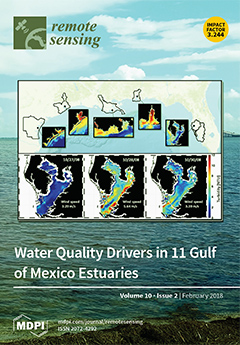Open AccessArticle
Atmospheric Correction Inter-Comparison Exercise
by
Georgia Doxani, Eric Vermote, Jean-Claude Roger, Ferran Gascon, Stefan Adriaensen, David Frantz, Olivier Hagolle, André Hollstein, Grit Kirches, Fuqin Li, Jérôme Louis, Antoine Mangin, Nima Pahlevan, Bringfried Pflug and Quinten Vanhellemont
Cited by 168 | Viewed by 15341
Abstract
The Atmospheric Correction Inter-comparison eXercise (ACIX) is an international initiative with the aim to analyse the Surface Reflectance (SR) products of various state-of-the-art atmospheric correction (AC) processors. The Aerosol Optical Thickness (AOT) and Water Vapour (WV) are also examined in ACIX as additional
[...] Read more.
The Atmospheric Correction Inter-comparison eXercise (ACIX) is an international initiative with the aim to analyse the Surface Reflectance (SR) products of various state-of-the-art atmospheric correction (AC) processors. The Aerosol Optical Thickness (AOT) and Water Vapour (WV) are also examined in ACIX as additional outputs of AC processing. In this paper, the general ACIX framework is discussed; special mention is made of the motivation to initiate the experiment, the inter-comparison protocol, and the principal results. ACIX is free and open and every developer was welcome to participate. Eventually, 12 participants applied their approaches to various Landsat-8 and Sentinel-2 image datasets acquired over sites around the world. The current results diverge depending on the sensors, products, and sites, indicating their strengths and weaknesses. Indeed, this first implementation of processor inter-comparison was proven to be a good lesson for the developers to learn the advantages and limitations of their approaches. Various algorithm improvements are expected, if not already implemented, and the enhanced performances are yet to be assessed in future ACIX experiments.
Full article
►▼
Show Figures





